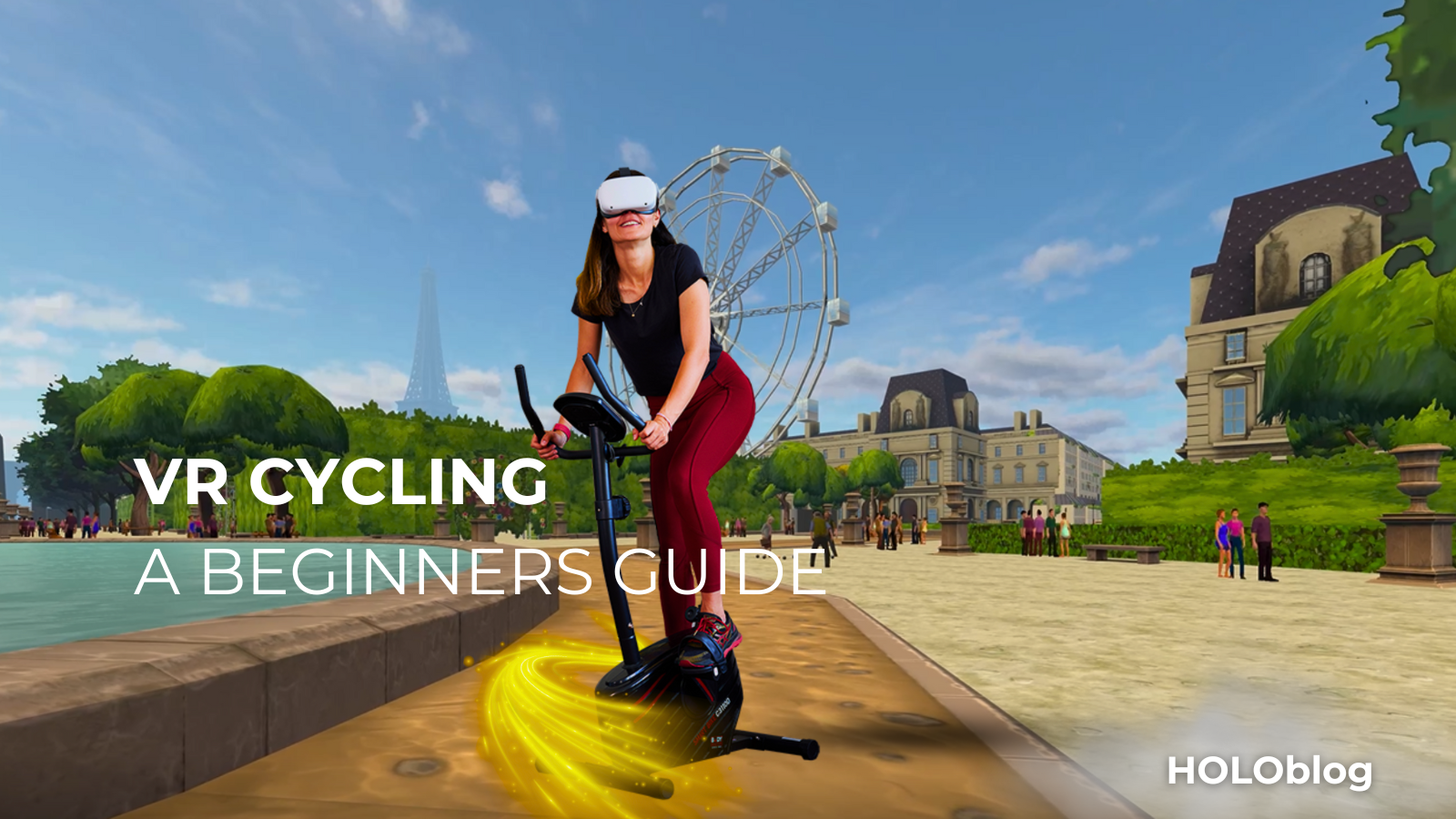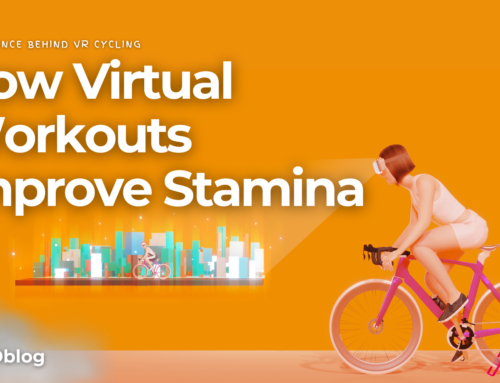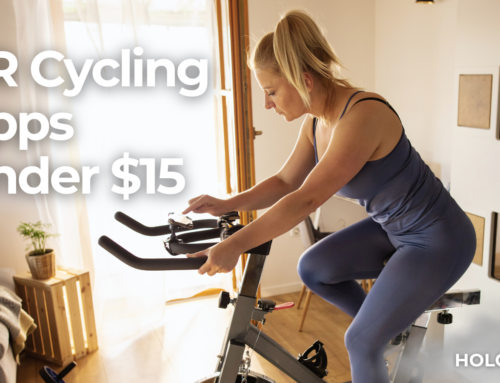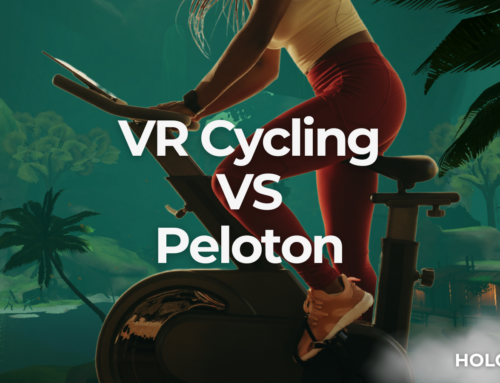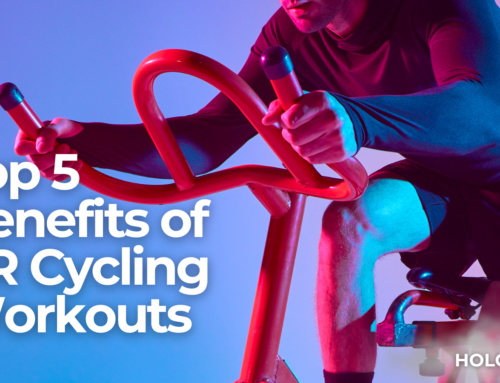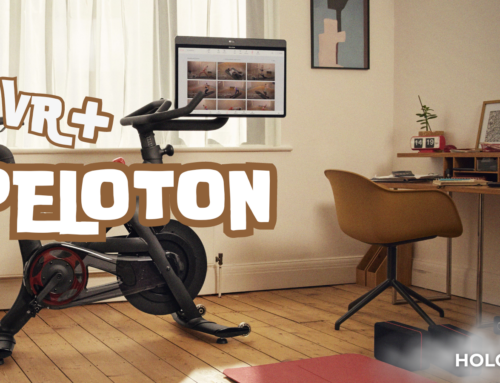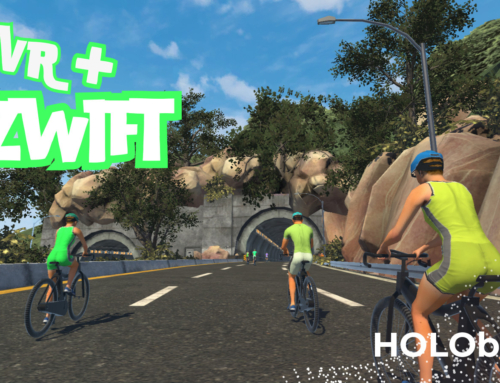So, you’ve got your Meta Quest, and the games are a blast. But did you know it’s also a powerful tool for indoor cycling? Yep! You can transform any indoor stationary bicycle into a VR machine easily!
If you’re looking for a fun way to lose weight and improve your health, VR cycling is one of the best options. It combines the intensity of a traditional cycling workout with the excitement of immersive virtual worlds.
Where do you begin? Don’t worry—this ultimate guide to VR cycling for beginners has got you covered
1. Introduction to VR Cycling
Virtual reality cycling is an immersive workout experience that combines traditional indoor cycling with engaging virtual environments.
Unlike traditional indoor cycling, which involves stationary bikes and maybe a TV or music, VR cycling (via a VR headset such as the Meta Quest) puts users in virtual worlds where they can cycle through incredible worlds, take part in challenges, or even ride with their friends in real-time from anywhere in the world.
Thanks to VR, these workouts no longer have to be boring. Instead of staring at the wall and counting down the minutes, each workout session can now feel like an exciting adventure.
2. Why Choose VR Cycling?
When we compare VR cycling to traditional indoor cycling, two factors stand out: fun and motivation. VR cycling can make your workout feel less repetitive and more enjoyable, yet it always challenges you to ensure you come back.
With VR cycling, you’ll become the main character of a virtual world. You’re free to explore the world at your own pace, engage in one of the guided training programs, depending on your fitness goals, or even train with or race against other users in the real-time multiplayer.
The visual elements of the world exist to keep you curious and engaged, while the gamified aspects such as tasks or challenges exist to drive your motivation.
Benefits over regular indoor cycling, such as improved motivation and immersive experiences.
How VR cycling can make workouts feel less repetitive and more enjoyable.
Sounds great, right? But did you know that all that was also proven by science?
Yep! VR fitness is proven to minimize pain during physical exercises, helping users exercise for longer and get quicker results.
A University of Kent study reported that exercising in VR lessens the perceived pain intensity by an incredible 10%. Moreover, University of Georgia researchers have found that high-intensity cycling is 12 – 13% less painful when combined with virtual reality.
3. Getting Started: What You Need
You’ll need just a few things to get started with VR cycling:
- Indoor bike: Great news! Any stationary bike is compatible with VR with a simple addition of a cadence sensor.
- Cadence sensor: We use a cadence sensor to connect to the VR headset via Bluetooth and transmit workout information. The cadence sensor is usually attached to the pedal crank of the bicycle. A variety of cadence sensors can work with VR, but we’ve prepared a list of our recommendations.
- Meta Quest headset: The Meta Quest headset is your portal into virtual reality. You can choose between the more affordable Meta Quest 3s and the Meta Quest 3.
The right VR app: There are only a few VR cycling apps such as HOLOFIT. Move on to the next part of this article to see the full list!
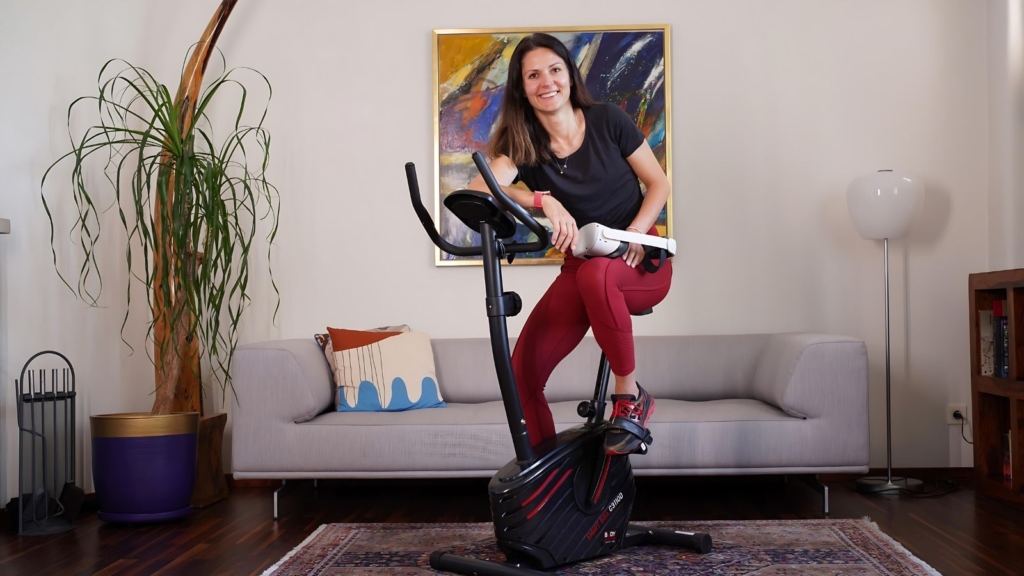
4. Choosing the Right VR Cycling App
Several VR cycling apps are available, each offering unique features and experiences. Here’s a quick comparison of popular apps:
HOLOFIT: A VR cycling app for the Meta Quest. Famous for its wide range of original virtual environments and game modes, including guided training programs and multiplayer. Also works with rowing machines, elliptical, and without any equipment through bodyweight exercises.
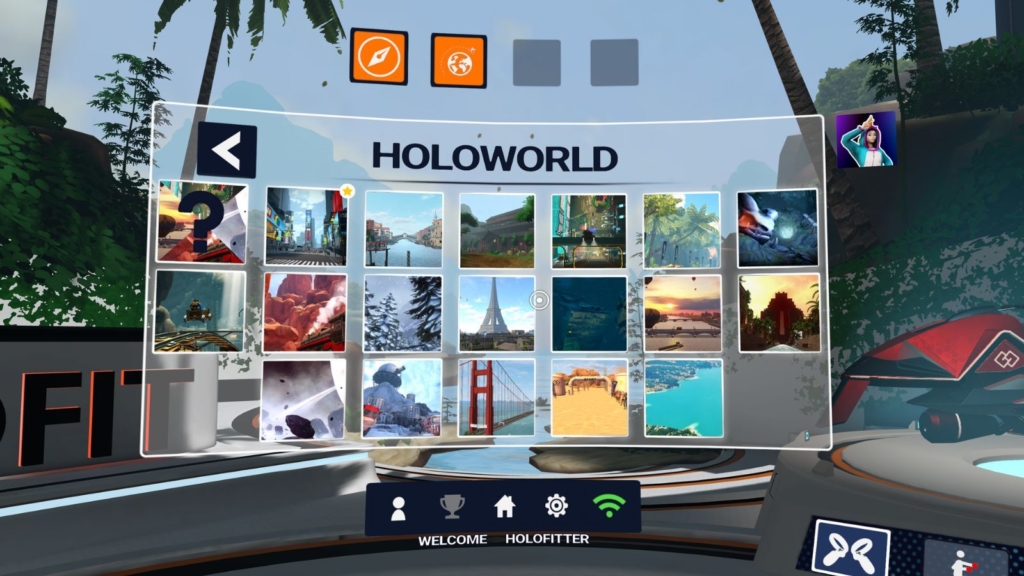
- Zwift: Zwift isn’t a VR cycling app, but it’s still a great tablet cycling app. It’s very popular with experienced cyclists looking for a more competitive, social experience with realistic race settings.
- VZfit: A VR cycling app for the Meta Quest. Doesn’t offer original virtual worlds. Instead, users can ride via Google Street View which provides great variety, but the quality of visuals is a bit choppy and it can be tricky adjusting for those with weaker stomachs.
Note that all these apps are subscription-based, but all offer free trials so that you can test them out for free, with no obligations. Consider your fitness goals when choosing an app. If you’re an experienced cyclist looking to improve your performance further, Zwift might suit you best, while HOLOFIT offers the best combo of fun and motivation for those who may be struggling to stick to their fitness routine.
5. Setting Up for Your First Ride
Setting up your indoor bike for your first VR cycling session is easier than you may think:
- Clear a safe, spacious area for cycling.
- Set up your bike and sensors (if using external sensors). The cadence sensor should be attached to the pedal crank. Full instructions on setting up your bike for VR cycling are available here.
- Adjust your VR headset to fit comfortably after sitting down on your bike.
- Start the VR app on your headset and follow the instructions! Most of these apps will take you through an onboarding process to take you through the app.
Always double-check for safety: make sure there’s enough room for movement and ensure your headset is secure to avoid discomfort during long sessions.
6. Tips for Beginners
Start small: Begin with shorter, 10-15 minute sessions to get used to the VR environment and avoid motion sickness, especially if this is your first time using VR.
That being said, note that some apps such as HOLOFIT were developed motion sickness-proof. HOLOFIT even has a patent for this! You still may experience some discomfort at the beginning if you’re not used to VR, but you’ll get used to it quickly.
Gradual Progression: Slowly increase the intensity and length of your rides as you grow more comfortable. To make progress, you should ensure each of your workouts is just challenging enough: not too hard, and not too easy.
Form Matters: Keep your back straight, engage your core, and avoid overextending your legs while riding. You’ll be surprised at the percentage of muscles you can engage with cycling!
7. Sample Beginner Workout Plan
Here’s a 2-week plan to help you ease into VR cycling:
- Week 1:
- Day 1: 10-minute casual ride (low intensity).
If you’re using an app like HOLOFIT, we recommend opting for the Journey mode which lets you set your own pace and explore one of the beautiful virtual worlds.
- Day 3: 15-minute scenic route (moderate intensity).
In VR, give one of the guided training programs a try. A 15-minute cardio program on easy or medium difficulty in one of the 15+ virtual worlds would be a great option.
- Day 5: 10-minute HIIT ride (moderate to high intensity).
Head to CardioGoals, and set up a 10-minute HIIT ride. Choose one of the worlds where you haven’t been before!
- Week 2:
- Day 1: 20-minute endurance ride (steady pace).
Try to keep a constant pace throughout your ride. Both the Journey and Zen modes would work great in HOLOFIT.
- Day 3: 15-minute casual ride (low intensity).
Journey Mode in HOLOFIT.
- Day 5: 10-minute HIIT ride (moderate to high intensity).
Head to CardioGoals and the guided HIIT program again. If it was too easy last time, increase the difficulty or vice versa!
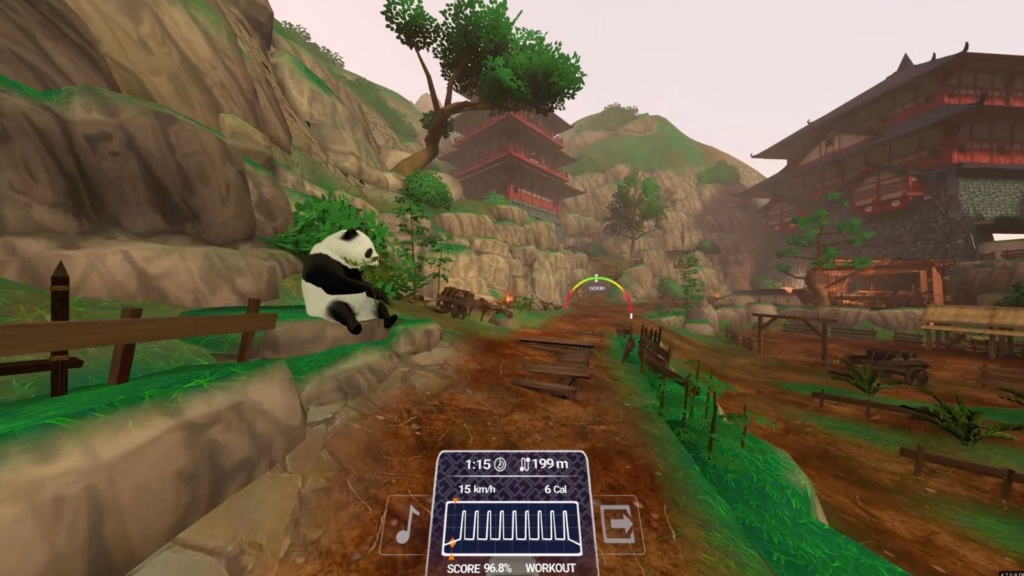
8. Common Challenges and How to Overcome Them
Technical issues: Meta Quest
For any Meta Quest technical issues, it’s best to contact Meta’s support team. You can easily reach them through their website: meta.com
Technical issues: Cadence Sensor
If your sensor isn’t connecting or you’re having some other issues with it, check troubleshooting guides: either from the sensor manufacturer or from the VR fitness app you’re using, they will usually have them ready. For example, if you’ve opted for HOLOFIT, consult the Frequently Asked Questions for the troubleshooting steps.
Motion sickness: If you’re prone to motion sickness or if you haven’t previously used VR, it’s a good idea to start using it in shorter sessions initially. Pro tip: Focus your eyes on a stable point in the virtual environment, it should help minimize it!
9. Frequently Asked Questions
1. Do I need a special bike for VR cycling?
No, any indoor bicycle works. You’ll just need to purchase a cadence sensor or a bike trainer to ensure Fitness Bluetooth connectivity (the kind of Bluetooth profile that transmits fitness info).
2. What VR headset do I need for VR cycling?
That depends on the VR fitness app you choose. That being said, most of them (HOLOFIT, VZfit) work with Meta Quest headsets. Currently, that would mean the Meta Quest 3S and the Meta Quest 3 are the best two options.
3. What kind of workouts can I do with VR cycling?
That depends on the VR cycling app you choose. For example, HOLOFIT offers a variety of game modes: journey mode where you can choose your own pace and explore the virtual worlds, guided cardio training programs such as HIIT, Fat Burn, etc, online multiplayer, monthly challenges that the whole community can take part in, bodyweight Combo Workouts that engage the whole body off the bike, and more.
4. Do I need an internet connection to do VR cycling?
Yes, most of these apps will require internet connection. You can just connect your VR headset to your home WiFi, and you’ll be good to go.
5. How can I track my progress?
Most VR apps offer in-depth performance tracking, including calories burned, distance covered, and intensity metrics. For example, HOLOFIT comes with its Companion App (available on iOS and Android) where you can save your workouts, progress through different game levels, rank on global and local leaderboards, and more.
10. Conclusion
VR cycling is an exciting way to take your indoor workouts to the next level, offering variety, motivation, and immersive experiences. It’s not only great for fitness but also for staying engaged and entertained.
Whether you’re looking to improve your cardio, boost your endurance, or just enjoy the ride, VR cycling is worth trying.
Ready to experience it for yourself? Try HOLOFIT for free and transform your cycling routine today!

